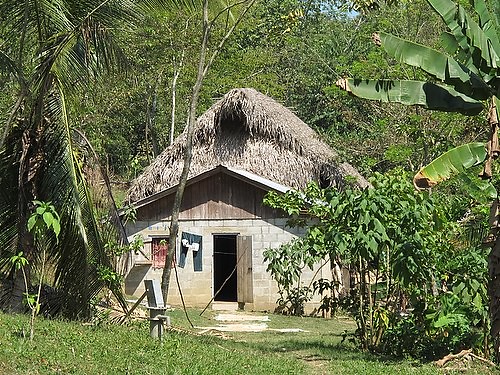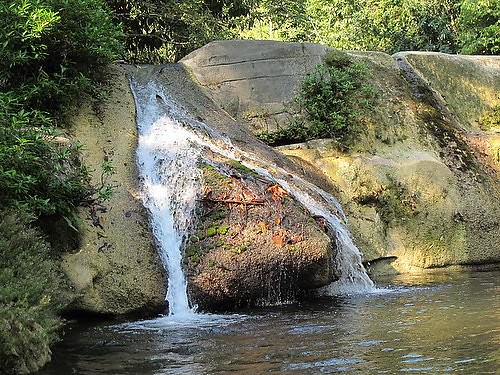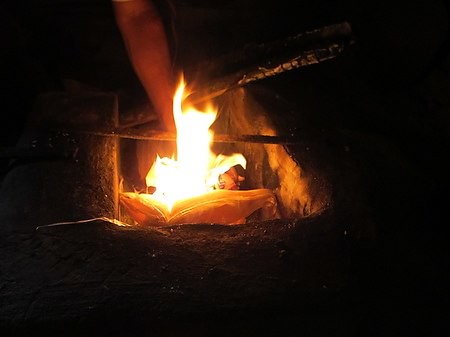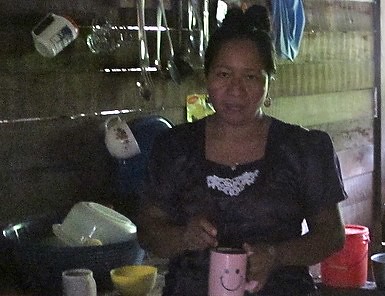SAN ANTONIO VILLAGE, Belize – The green school bus was already full when I climbed aboard in Punta Gorda. It was market day, and all the Maya ladies with their colorful satin dresses sat amid their purchases and their children, ready to make the journey home. As my eyes sought an opening, one of the men in the back got up and approached me with a broad smile.
It was Reyes Chun, chair of the Toledo Ecotourism Association, who lives in San Antonio Village, which is why I chose to come here. “This is my wife, Jenny,” he said, pointing to a smiling woman in purple satin, her hair combed carefully into a tight knot. “She will take care of you.”
Jenny and I chatted for the 40-minute drive, most of it down rugged and rutted gravel roads through the jungle. I asked her about the coming of the Guatemala Link Road, a feeder road for the Puebla to Panama highway, which will pave the way for the Free Trade Zone of the Americas. The highway is slated to run a few miles from her village, I have been told.
I’ve read a consultant’s report warning of severe environmental and community degradation in the highway’s wake if the government doesn’t provide a plan for their protection, and San Antonio is on the list of affected communities. Jenny doesn’t know about this. She’ll be glad to get to town more quickly, and she hopes that with the highway, electricity will come to the rest of the village. For now, however, this all seems a distant mirage.
The afternoon sun beat down unmercifully on the zinc roof of the one-room cement-block house, but still it was a welcome respite from the wilting rays outside. Another, larger one, wooden with a thatched roof, was behind it – later I learned it was the kitchen. But now it was time for Jenny’s son Noel to take me to the guesthouse, which would be my quarters during my stay.
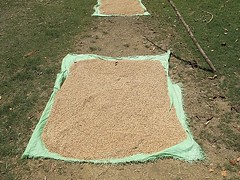 He led me out past the rice drying on huge mats in the hot sun, down a footpath and into the jungle. There in a clearing along the path was a thatch-roofed wooden building with everything I needed – a table and chairs, beds with mosquito netting, a comfortable wooden-framed love seat, a large patio looking out onto the jungle – and best of all, a colorful hammock. This is where I was to wait until someone came for me.
He led me out past the rice drying on huge mats in the hot sun, down a footpath and into the jungle. There in a clearing along the path was a thatch-roofed wooden building with everything I needed – a table and chairs, beds with mosquito netting, a comfortable wooden-framed love seat, a large patio looking out onto the jungle – and best of all, a colorful hammock. This is where I was to wait until someone came for me.
Under the guesthouse plan devised by the Toledo Ecotourism Association, different families would come at different times of day to take me to their homes to share meals with them. A variety of tours and activities were available: a village tour, a farm tour, a walk to the waterfall, lessons in embroidery or basketweaving or tortilla making.
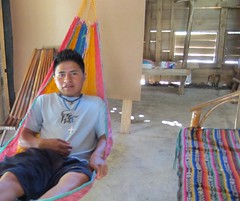 I signed up for all three of the tours and stepped into the guesthouse, a blessed respite from the unrelenting sun. The thatch was much cooler than the zinc-roofed house below, designed to let the breezes flow through while providing a thick mat of protection from the relentless rays. Now I understood why each family had a thatch house as well as the cement and zinc one; the thatch house was cool and comfortable, but it took a lot of work to construct and maintain, Noel explained. The cement one could be relied upon when the other was down for repairs.
I signed up for all three of the tours and stepped into the guesthouse, a blessed respite from the unrelenting sun. The thatch was much cooler than the zinc-roofed house below, designed to let the breezes flow through while providing a thick mat of protection from the relentless rays. Now I understood why each family had a thatch house as well as the cement and zinc one; the thatch house was cool and comfortable, but it took a lot of work to construct and maintain, Noel explained. The cement one could be relied upon when the other was down for repairs.
As he headed off down the path, I felt a twinge of anxiety. Nothing to do! I should have brought my computer, I scolded myself. I could have been writing.
It was far too hot for a tour, and nobody in the village seemed to be moving. Even the birds in the trees were quiet; only an occasional rooster broke the silence.
I sat on the wooden bench for awhile, contemplating my options. Finally I did what any sensible traveler would do; I clambered into the hammock, which I discovered had been strategically placed to catch the breeze.
I observed the herringbone-like pattern created by the overlapping cohune palm leaves overhead, the local material used to make thatch. I examined the way they were tied together and to the wooden beams with what looked like vines. Later, Reyes showed me the vines they used to do this work – they belonged to the monestera philodendron, commonly known to most North Americans as house plants – only these were growing up skyscraper-tall trees, with leaves the size of a tabletop.
My eyes grew heavy. The hammock swung gently in the breeze.
“How nice that I don’t have a computer,” I thought.
Suddenly I awoke to the sound of a gentle whirring outside, near the eves. I listened intently: zip, whir. Zip, whir. A hummingbird – hovering right above my hammock! The creature had zipped in under the eaves, where it hovered for a few seconds before zipping out the other side, then hovering overhead again, as if to deliver a blessing. Then, in a whir of bright green and red, it was gone.
There was little time for lollygagging, however. Noel and 12-year-old Jeffrey were soon heading up the path to take me to the waterfall.
As we made our way through the thatched-house village and into the jungle beyond, I asked him about his future plans.
Noel is studying accounting and planning to move away from the Toledo district – probably to the nation’s capital, Belmopan – so that he can find a job and raise a family. He’d love to stay closer to home, he says, but there are so few jobs in Toledo. The alternative, he says, would be to stay here and work his father’s cacao farm, but with six sons and a daughter, it’s clear there’s not enough to go around.
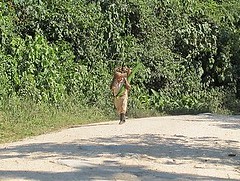 The Chuns are actually fairly well off compared to many. Reyes is working overtime to send his children to high school, which is not free in Belize. More than two-thirds of the people in this district are considered poor, and more than half are considered extremely poor.
The Chuns are actually fairly well off compared to many. Reyes is working overtime to send his children to high school, which is not free in Belize. More than two-thirds of the people in this district are considered poor, and more than half are considered extremely poor.
 “My father is working hard on a plan to get more jobs here,” says Noel. “I really hope he can be successful.”
“My father is working hard on a plan to get more jobs here,” says Noel. “I really hope he can be successful.”
Noel is talking about the Toledo People’s Eco Park, a far-reaching plan that the Toledo Ecotourism Association has been hammering out, a plan that builds on the success of the guesthouse program and goes far beyond tourism to promote reforestation, sustainable agriculture and eco-manufacturing while creating jobs in the local economy.
The TEA, a group with representatives from all the region’s major cultural groups, has been working on this plan for a number of years and has come close to garnering governmental and NGO support, but thus far, it has not been able to get significant funding for this plan. The hope is that the highway will provide the catalyst to finally put the plan in place.
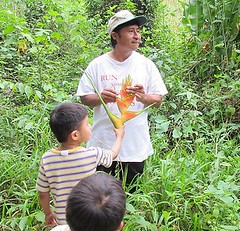 Reyes hopes the coming of the highway will bring the resources necessary to finally put the Eco Park plan into motion. On the one hand, he reasons, it could bring opportunities and money to the Forgotten District. But he hopes Toledo can learn a lesson from the Cayo District, where the gains have been reaped largely by international developers.
Reyes hopes the coming of the highway will bring the resources necessary to finally put the Eco Park plan into motion. On the one hand, he reasons, it could bring opportunities and money to the Forgotten District. But he hopes Toledo can learn a lesson from the Cayo District, where the gains have been reaped largely by international developers.
“In the Toledo district we should learn by example,” he said. “What we want to do in Toledo is a complete vice versa to the example of the Cayo District. The TEA should be the steward to actually motivate people to know what the highway will bring. I know for sure once the highway is open and our land is not secure and our resources are being hampered, then it will be a total loss, and we will not become the owners of our own resources.”
Back at the guesthouse, the sun was dropping behind the trees, and I dug out my flashlight and prepared for the pitch-blackness. A youngster named Lupio fetched me to take me to his grandmother Romalda’s house for rice and beans.
I climbed a rugged footpath up to where the compound sits, surrounded by jungle. This is where Reyes grew up; Romalda is his mother. Chickens and pigs scratch in the dust outside her thatched house. Romalda and her daughter Tomasa are squatting in front of the fire, making fresh corn tortillas, when I arrive.
Romalda rises to show me to the table, and she reaches for a kerosene lamp, which she fills and lights, as it’s growing dim.
Tomasa is deaf, she explains, but very smart. I can communicate with her using sign language, she explains.
The eggs are delicious, prepared with tomatoes and onion and served with beans and rice. Romalda wants to know where I’m from.
She tells me of her nine children, only three of whom still live in the village: Tomasa, Reyes, and another daughter who is also deaf. All the others have gone to distant towns to make a living.
“They say that the highway is coming, that it will bring jobs and electricity,” she says. “They’ve been saying that for so many years – I don’t know now if I will see it before I die.” She gives a resigned laugh.
I stand to help with the dishes, and Tomasa pours cold water and a bit of soap powder into a plastic tub. I wash, she rinses; soon, however, she shakes her head firmly. She hands me the cup I’ve just washed and runs a finger over it, making a face; it’s greasy, I understand. So is this one, and this one. Obviously I need schooling in this art. We laugh together and I begin again.
As I take my leave, Tomasa touches her lips with her hand and extends it toward me, smiling, and I reach for it. But Rowena laughs.
“She’s saying thank you,” said Romalda. Suddenly I understand – this is universal sign language. I touch my lips, extend my hand and smile in thanks and in farewell.
In the morning, there’s breakfast with Jenny, where she shows me some of her handmade creations: fine embroidery, necklaces of bead grass and basketry made from the local jippi jappa palm.


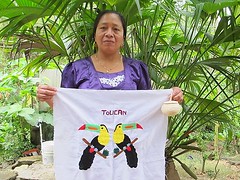
Then it’s time for a tour of Reyes’ cacao farm, together with a walking workshop on scores of medicinal plants along the way.

Back at the guesthouse, I wait on the front porch and watch the palm leaves dance in the breeze. Rosita and her friend are walking down the path with baskets full of clothing, headed for the deep spot in the creek I’d never noticed, just below the tree line. There amid the trees they scrub their clothes and bathe, chatting and giggling amiably.
A world lost to time, it seemed – but only for a few moments more. Change is coming to this village, and to dozens more that will be affected by the Southern Highway. I think of the stream that provides the village lifeline; the little boy making a gang sign at me as I passed by; the friendly young man who works in Belize City, home for a visit, who worries about what will become of his village.
But it’s time to catch the bus back to Punta Gorda Town, and I’m late. I say my goodbyes to the Chun family, catch a bumpy ride in a pickup truck and feel the wind on my face.
Created with Admarket’s flickrSLiDR.
